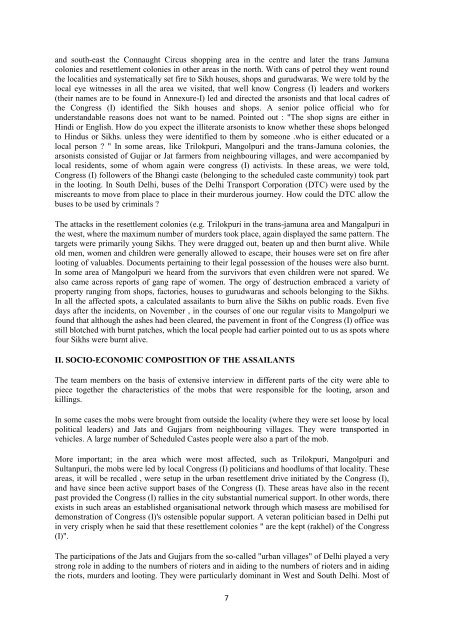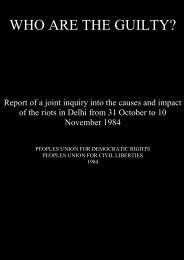Who are the Guilty(1)
Who are the Guilty(1)
Who are the Guilty(1)
You also want an ePaper? Increase the reach of your titles
YUMPU automatically turns print PDFs into web optimized ePapers that Google loves.
and south-east <strong>the</strong> Connaught Circus shopping <strong>are</strong>a in <strong>the</strong> centre and later <strong>the</strong> trans Jamuna<br />
colonies and resettlement colonies in o<strong>the</strong>r <strong>are</strong>as in <strong>the</strong> north. With cans of petrol <strong>the</strong>y went round<br />
<strong>the</strong> localities and systematically set fire to Sikh houses, shops and gurudwaras. We were told by <strong>the</strong><br />
local eye witnesses in all <strong>the</strong> <strong>are</strong>a we visited, that well know Congress (I) leaders and workers<br />
(<strong>the</strong>ir names <strong>are</strong> to be found in Annexure-I) led and directed <strong>the</strong> arsonists and that local cadres of<br />
<strong>the</strong> Congress (I) identified <strong>the</strong> Sikh houses and shops. A senior police official who for<br />
understandable reasons does not want to be named. Pointed out : "The shop signs <strong>are</strong> ei<strong>the</strong>r in<br />
Hindi or English. How do you expect <strong>the</strong> illiterate arsonists to know whe<strong>the</strong>r <strong>the</strong>se shops belonged<br />
to Hindus or Sikhs. unless <strong>the</strong>y were identified to <strong>the</strong>m by someone .who is ei<strong>the</strong>r educated or a<br />
local person ? " In some <strong>are</strong>as, like Trilokpuri, Mangolpuri and <strong>the</strong> trans-Jamuna colonies, <strong>the</strong><br />
arsonists consisted of Gujjar or Jat farmers from neighbouring villages, and were accompanied by<br />
local residents, some of whom again were congress (I) activists. In <strong>the</strong>se <strong>are</strong>as, we were told,<br />
Congress (I) followers of <strong>the</strong> Bhangi caste (belonging to <strong>the</strong> scheduled caste community) took part<br />
in <strong>the</strong> looting. In South Delhi, buses of <strong>the</strong> Delhi Transport Corporation (DTC) were used by <strong>the</strong><br />
miscreants to move from place to place in <strong>the</strong>ir murderous journey. How could <strong>the</strong> DTC allow <strong>the</strong><br />
buses to be used by criminals ?<br />
The attacks in <strong>the</strong> resettlement colonies (e.g. Trilokpuri in <strong>the</strong> trans-jamuna <strong>are</strong>a and Mangalpuri in<br />
<strong>the</strong> west, where <strong>the</strong> maximum number of murders took place, again displayed <strong>the</strong> same pattern. The<br />
targets were primarily young Sikhs. They were dragged out, beaten up and <strong>the</strong>n burnt alive. While<br />
old men, women and children were generally allowed to escape, <strong>the</strong>ir houses were set on fire after<br />
looting of valuables. Documents pertaining to <strong>the</strong>ir legal possession of <strong>the</strong> houses were also burnt.<br />
In some <strong>are</strong>a of Mangolpuri we heard from <strong>the</strong> survivors that even children were not sp<strong>are</strong>d. We<br />
also came across reports of gang rape of women. The orgy of destruction embraced a variety of<br />
property ranging from shops, factories, houses to gurudwaras and schools belonging to <strong>the</strong> Sikhs.<br />
In all <strong>the</strong> affected spots, a calculated assailants to burn alive <strong>the</strong> Sikhs on public roads. Even five<br />
days after <strong>the</strong> incidents, on November , in <strong>the</strong> courses of one our regular visits to Mangolpuri we<br />
found that although <strong>the</strong> ashes had been cle<strong>are</strong>d, <strong>the</strong> pavement in front of <strong>the</strong> Congress (I) office was<br />
still blotched with burnt patches, which <strong>the</strong> local people had earlier pointed out to us as spots where<br />
four Sikhs were burnt alive.<br />
II. SOCIO-ECONOMIC COMPOSITION OF THE ASSAILANTS<br />
The team members on <strong>the</strong> basis of extensive interview in different parts of <strong>the</strong> city were able to<br />
piece toge<strong>the</strong>r <strong>the</strong> characteristics of <strong>the</strong> mobs that were responsible for <strong>the</strong> looting, arson and<br />
killings.<br />
In some cases <strong>the</strong> mobs were brought from outside <strong>the</strong> locality (where <strong>the</strong>y were set loose by local<br />
political leaders) and Jats and Gujjars from neighbouring villages. They were transported in<br />
vehicles. A large number of Scheduled Castes people were also a part of <strong>the</strong> mob.<br />
More important; in <strong>the</strong> <strong>are</strong>a which were most affected, such as Trilokpuri, Mangolpuri and<br />
Sultanpuri, <strong>the</strong> mobs were led by local Congress (I) politicians and hoodlums of that locality. These<br />
<strong>are</strong>as, it will be recalled , were setup in <strong>the</strong> urban resettlement drive initiated by <strong>the</strong> Congress (I),<br />
and have since been active support bases of <strong>the</strong> Congress (I). These <strong>are</strong>as have also in <strong>the</strong> recent<br />
past provided <strong>the</strong> Congress (I) rallies in <strong>the</strong> city substantial numerical support. In o<strong>the</strong>r words, <strong>the</strong>re<br />
exists in such <strong>are</strong>as an established organisational network through which masess <strong>are</strong> mobilised for<br />
demonstration of Congress (I)'s ostensible popular support. A veteran politician based in Delhi put<br />
in very crisply when he said that <strong>the</strong>se resettlement colonies " <strong>are</strong> <strong>the</strong> kept (rakhel) of <strong>the</strong> Congress<br />
(I)".<br />
The participations of <strong>the</strong> Jats and Gujjars from <strong>the</strong> so-called "urban villages" of Delhi played a very<br />
strong role in adding to <strong>the</strong> numbers of rioters and in aiding to <strong>the</strong> numbers of rioters and in aiding<br />
<strong>the</strong> riots, murders and looting. They were particularly dominant in West and South Delhi. Most of<br />
7



